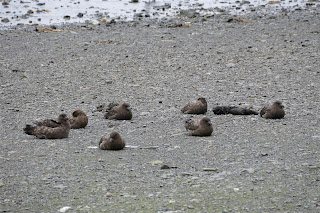So I have written about all sorts so far –
geeps,
skuas,
wanals and
mollies, brief interludes with
seals and
white-chins, and even why we are all
blonde! But given my job title there
has been something distinctly lacking and it is time to put that right.... so
here come the penguins!
First up we unfortunately have to get through some bad news.
This year has been a disastrous year for our gentoo colonies with no breeding attempts being successful! The cause of this is being investigated but luckily
I did get to see some hatch before they failed; however, this actually made the
feeling of their bad time worse.
 |
| Gentoos on nest; a hatching; gentoo chick |
But this is not a first time thing for the gentoos. Poor breeding years have happened in the past but the adult population
survives to try again in better conditions the next year. So fingers crossed I
bring you news of a good gentoo season next summer! However, not all penguin
news is bad news; the macs are doing just fine!
 |
| Macaroni penguins |
We have a number of different workstreams around the penguin
colonies, all designed to better understand the population. Our work focuses in
two colonies on the west side of BI; Little Mac and Big Mac.
 |
| Little Mac and Fairy Point Hut with a view of Big Mac in the background |
Big Mac is absolutely awe-inspiring! To be amongst 80,000
penguins is an incredible experience, even if the weather on BI is so changeable that one
minute we are counting in clear, but still cold, weather and the next a snow flurry is obscuring our
view!
 |
| Changeable weather for counting macs - 10 minutes separates these photos! |
Obviously counting so many penguins regularly would be
impossible. As such we have transects through the colony that remain constant
every year – marked by yellow stones – that are counted so that we can study
any changes in the population. The transects are counted once during incubation
and again when the chicks are hatching.
 |
| Incubating an egg and caring for a chick |
Little Mac however is small enough that the entire colony is
counted on the same days as the Big Mac transects. Whilst it is smaller it is
actually much harder to count! Just a mass of penguins with no discernible
boundaries within the colony makes accurately counting every penguin on a nest
quite difficult.
 |
| Anyone fancy counting? Remember to only count those on a nest! :) |
Even though counting them can be challenging at times it is
impossible not to enjoy the work because being in the colonies of such funky
little birds is absolutely magnificent!
 |
| Can't get enough of these cool little penguins |
 |
| Their feathers are so thick and waterproof that the snow just sticks to the edge of them |
 |
| Directing the traffic through the colony! |































